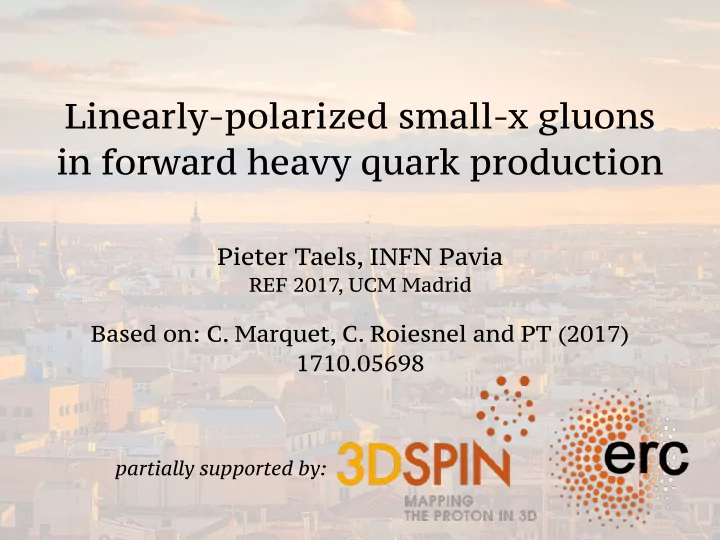

Linearly-polarized small-x gluons in forward heavy quark production Pieter Taels, INFN Pavia REF 2017, UCM Madrid Based on: C. Marquet, C. Roiesnel and PT (2017) 1710.05698 partially supported by:
Reminder: Small-x evolution 2
Bremsstrahlung d k 2 d P ' α s C R d x ⊥ k 2 x π ⊥ x = k + /p + Radiative corrections can be very large if there is enough phase space for gluon emission available Two possible sources of large logarithmic enhancements: Z Q 2 d k 2 = α s ln Q 2 ⊥ collinear emission α s k 2 µ 2 µ 2 ⊥ 0 0 Z 1 d z z = α s ln 1 α s soft emission x x d P ≥ 1 When , the notion of probability is lost! 3
DGLAP (collinear factorization) α s ln Q 2 resum collinear logs: µ 2 0 grows treat energy exact Z 1 d ⇣ x � x + x � x P gg ( z ) x � x h X z , Q 2 �⌘ z , Q 2 �i d ln Q 2 xg ( x, Q 2 ) = α s ˜ + ˜ z , Q 2 � d z P gq ( z ) z ¯ z q f q f z g 2 π x f 4
BFKL (kT factorization) resum soft logs: α s ln 1 x decreases x treat transverse momentum exact Pertains to unintegrated gluon PDFs Z d 2 p ⊥ k 2 ✓ ◆ x d g ( x, k ⊥ ) g ( x, p ⊥ ) − 1 = α s N c ⊥ 2 g ( x, k ⊥ ) p 2 d x ⊥ ( k ⊥ − p ⊥ ) 2 π π 5 5
Problems with BFKL Lifetime of each gluon ∆ t ∼ k + /k 2 ⊥ Explosive growth of the gluon density: 1 g ( x, k 2 ⊥ ) ∼ x 2 . 77( α s N c / π ) Problems : • Violation of unitarity • Diffusion of the solution into the nonperturbative domain • With increasing density, expect recombinations: “Saturation” 6
Color Glass Condensate McLerran-Venugopalan (MV) model for a large nucleus: valence quarks are frozen in time and sharply located vs wee gluons are short-living and d elocalized Valence quarks are static sources for classical gluon fields generate gluons through Yang-Mills equations ∼ 1 Natural interpretation of saturation Q 2 as overlap of gluons in transverse plane ϕ ( x, Q 2 ) ∝ g ( x, Q 2 ) ϕ ( x, Q 2 g ( x, Q 2 ) ∼ ln Q 2 s ) = 1 Q 2 Q 2 s 7
Color Glass Condensate Sources follow Gaussian distribution: Correlators: Lowering <-> shifting separation valence - wee gluons x Include layers of soft gluons into hard sources leads to the nonlinear JIMWLK evolution equation: x ∂ ∂ x Φ x = H JIMWLK Φ x Applied to a dipole, reduces to Balitsky-Kovchegov eq., which is nonlinear extension of BFKL Gelis, Iancu, Jalilian-Marian & Venugopalan, 1002.0333
QCD evolution 9
Small-x gluon TMDs Dominguez, Xiao, Yuan, PRL 106 (2011) Dominguez, Marquet, Xiao, Yuan, PRD 83 (2011) Metz, Zhou, PRD 84 (2011) Akcakaya, Schaefer, Zhou, PRD 87 (2013) Kotko, Kutak, Marquet, Petreska, Sapeta & van Hameren, JHEP 1509 (2015) Marquet, Petreska, Roiesnel, JHEP 1610 (2016) Boer, Mulders, Pisano, Zhou, JHEP 1608 (2016) Marquet, Roiesnel, Taels (2017) 1710.05698 Boer, Mulders, Zhou & Zhou (2017) 1702.08195 Talk by Boer 10
Forward heavy-quark production in pA collisions In forward production: and x p ∼ 1 x A ⌧ 1 Three relevant scales: q ⊥ ≡ | p 1 t + p 2 t | ˜ Q s (small) (large) P ⊥ ∼ p 1 t ∼ p 2 t Approximately: ˜ P 2 ⊥ ⇠ 10 − 5 down to: x A ' x s ˆ 11
Two regimes Q s ⌧ q ⊥ ⇠ ˜ Dilute regime (linear - BFKL) P ⊥ q ⊥ ⇠ Q s ⌧ ˜ Saturation regime (nonlinear - BK-JIMWLK) P ⊥ the quarks are almost back-to-back 12 12
CGC calculation x g y P Multiple eikonal scatterings off gluons in the nucleus resummed into Wilson lines 13 13
CGC calculation z ≡ k + 1 p + wave function g → q ¯ q Interaction of dipole with nucleus: 14
q ⊥ ⇠ Q s ⌧ ˜ Result in back-to-back limit P ⊥ Six different gluon TMDs appear Three unpolarized TMDs with three linearly-polarized ones cos φ = q ⊥ · ˜ P ⊥ Linearly polarized gluons couple via mass, q ⊥ ˜ φ P ⊥ and via angle cfr. Boer, Mulders, Pisano PRD 80 (2009) 15
Matching with TMD approach small- x limit -dependence only x inside CGC averages 16
Numerics TMDs are nonperturbative objects which need to be measured However, we have the CGC, which provides a well-founded model TMDs are computed within the McLerran-Venugopalan model Evolved numerically towards smaller values of with JIMWLK x 17
Recommend
More recommend